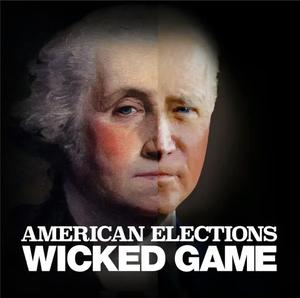
Lost at the Smithsonian with Aasif Mandvi
Stitcher, Aasif Mandvi
Comedian and pop culture fanatic Aasif Mandvi gets up close and personal with the most iconic artifacts at the National Museum of American History. Join Aasif and his guests as they explore how vintage clothing, ratty furniture, and mismatched shoes transformed into Fonzie's leather jacket, Archie Bunker's chair, and Dorothy's ruby slippers and became defining symbols of American culture along the way.
- 35 minutes 38 secondsThe Original Muppets
Jim Henson created hundreds of Muppets. Many of them are well known, but there are a whole bunch of Muppets from the early days that most people haven't even heard of. The Smithsonian has more than 30 of those original, obscure Muppets including the original lizard-like Kermit who was made from an old green coat Henson's mother threw out.
25 November 2019, 5:00 am - 33 minutes 4 secondsBee Gees' Silver Suits
The Bee Gees -- Barry, Robin and Maurice Gibb, were among the most successful vocal groups in rock and roll history, helping define the disco era with their falsetto harmonies and funky beats. The Australian band's silver suits at the Smithsonian are from their 1978 tour, riding on the heels of their album for the movie "Saturday Night Fever," one of the top selling soundtracks in history.
21 November 2019, 5:00 am - 28 minutes 59 secondsPelé's #10 Jersey
Professional soccer player, Pelé -- did more for the sport's global appeal than anyone in history. He did so much that the International Olympic Committee named him the athlete of the century. In 1975, he came out of retirement in Brazil, put on his unassuming white mesh jersey with the number ten on it and went to play with the New York Cosmos, lifting the sport from a sleepy backwater in the U.S. to having unprecedented interest today.
This episode is sponsored by Parcast - Mythology (www.parcast.com/MYTHOLOGY) and Bayer.
14 November 2019, 5:00 am - 32 minutes 59 secondsArchie Bunker's Chair
All in the Family was a groundbreaking sitcom. Its pilot episode came with a trigger warning, and every episode thereafter came with a hefty dose of retrograde political commentary from Archie Bunker. So why is the chair in the Smithsonian? How did this piece of furniture make it from a second hand store in Los Angeles to the National Museum of American History in DC? (Celeb interviews: Hector Elizondo and Norman Lear)
This episode is sponsored by Bayer.
7 November 2019, 5:00 am - 31 minutes 17 secondsCarrie Bradshaw's Laptop
Carrie Bradshaw was the voice of HBO's groundbreaking comedy Sex and the City. Launching in 1998, each episode was built around Bradshaw writing her weekly column and uncensored voice and actions of four women who rode the roller coaster of modern sexual relationships. Her laptop now resides at the Smithsonian. Host Aasif Mandvi (who had a role on the show as Dmitri, a computer tech) explores the show's enduring appeal. (Celeb interview: Candace Bushnell).
This episode is sponsored by Bayer and The Great Courses (www.thegreatcoursesplus.com/LOST).
31 October 2019, 4:00 am - 34 minutes 48 secondsMuhammad Ali's Robe
Muhammad Ali was a legendary boxer and much, much more. Finding the robe Ali wore during training gives Aasif a chance to get into the history of one of the biggest sporting events of all time: The Rumble in the Jungle. (Celeb interview: Reporter, Jerry Izenberg)
This episode is sponsored by Bayer and The Great Courses (www.thegreatcoursesplus.com/LOST).
24 October 2019, 4:00 am - 28 minutes 54 secondsPhyllis Diller's Gag File
Phyllis Diller was a 38-year old, practically homeless mother of five when she started her standup career. She was a trailblazer, using her jokes to open doors for all the women who would come after her. In a lucky break for history, she was also a compulsive note taker and gave a filing cabinet with 50,000 jokes to the Smithsonian for safe keeping.
17 October 2019, 4:00 am - 34 minutes 40 secondsDorothy's Ruby Slippers
The Ruby Slippers Judy Garland wore in The Wizard of Oz are one of the most popular items at the Smithsonian's National Museum of American History. So why is the pair on display mismatched? And what does the FBI have to do with it?
10 October 2019, 4:00 am - 31 minutes 10 secondsJose Felciano’s Guitar
Jose Feliciano was the first artist to perform a personalized rendition of the National Anthem at the World Series, and it nearly destroyed his career. But was it an act of protest or of patriotism? Also, Aasif gets a private concert when Jose Feliciano is reunited with his guitar at the Smithsonian. (Celeb interview: Jose Feliciano)
This episode is sponsored by The Great Courses (www.thegreatcoursesplus.com/LOST).
3 October 2019, 4:00 am - 34 minutes 45 secondsFonzie's Jacket
The Fonz was the breakout character on the sitcom Happy Days, and his leather jacket became a symbol of coolness itself. But why? And how did Henry Winkler turn The Fonz into an American icon? (Celeb interview: Henry Winkler)
This episode is sponsored by The Great Courses (www.thegreatcoursesplus.com/LOST) and Vistaprint (www.vistaprint.com code: LOST).
26 September 2019, 4:00 am - 2 minutes 41 secondsComing Soon: Lost at the Smithsonian
Prepare yourself to get Lost at the Smithsonian, with Aasif Mandvi, as he explores the little-known stories behind iconic pop culture artifacts at the National Museum of American History. Coming September 26th, 2019.
9 September 2019, 8:00 pm - More Episodes? Get the App
Your feedback is valuable to us. Should you encounter any bugs, glitches, lack of functionality or other problems, please email us on [email protected] or join Moon.FM Telegram Group where you can talk directly to the dev team who are happy to answer any queries.
 CAUTIONARY TALES with Jason Pettigrew
CAUTIONARY TALES with Jason Pettigrew
 The Alarmist
The Alarmist
 Bear and a Banjo
Bear and a Banjo
 American Elections: Wicked Game
American Elections: Wicked Game
 Mental Floss Presents: The Quest for the North Pole
Mental Floss Presents: The Quest for the North Pole
 Scattered
Scattered